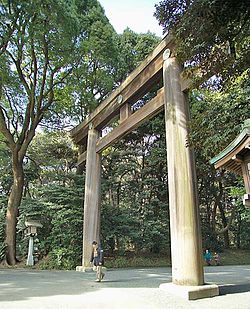Meiji jingu
| Meiji Shrine 明治神宮 |
|
|---|---|

Torii leading to the Meiji Shrine complex
|
|
| Information | |
| Type | Imperial Shrine |
| Dedicated to |
Emperor Meiji Empress Shoken |
| Founded | November 1, 1920 |
| Address | 1-1, Kamizono-chō, Yoyogi, Shibuya, Tokyo 151-0053 |
| Website | www |
|
|
|
Meiji Shrine (明治神宮 Meiji Jingū), located in Shibuya, Tokyo, is the Shinto shrine that is dedicated to the deified spirits of Emperor Meiji and his wife, Empress Shōken. The shrine does not contain the emperor's grave, which is located at Fushimi-momoyama, south of Kyoto.
After the emperor's death in 1912, the Japanese Diet passed a resolution to commemorate his role in the Meiji Restoration. An iris garden in an area of Tokyo where Emperor Meiji and Empress Shōken had been known to visit was chosen as the building's location.
Construction began in 1915 under Itō Chūta, and the shrine was built in the traditional nagare-zukuri style, using primarily Japanese cypress and copper. The building of the shrine was a national project, mobilizing youth groups and other civic associations from throughout Japan, who contributed labor and funding. It was formally dedicated in 1920, completed in 1921, and its grounds officially finished by 1926. Until 1946, the Meiji Shrine was officially designated one of the Kanpei-taisha (官幣大社), meaning that it stood in the first rank of government supported shrines.
The original building was destroyed during the Tokyo air raids of World War II. The present iteration of the shrine was funded through a public fund raising effort and completed in October 1958.
Meiji Shrine has been visited by numerous foreign politicians, including United States President George W. Bush, United States Secretary of State Hillary Clinton, and German Foreign Minister Guido Westerwelle.
Meiji Shrine is located in a forest that covers an area of 70 hectares (170 acres). This area is covered by an evergreen forest that consists of 120,000 trees of 365 different species, which were donated by people from all parts of Japan when the shrine was established. The forest is visited by many as a recreation and relaxation area in the center of Tokyo. The entrance to the shrine complex leads through the Jingu Bashi bridge.
...
Wikipedia
